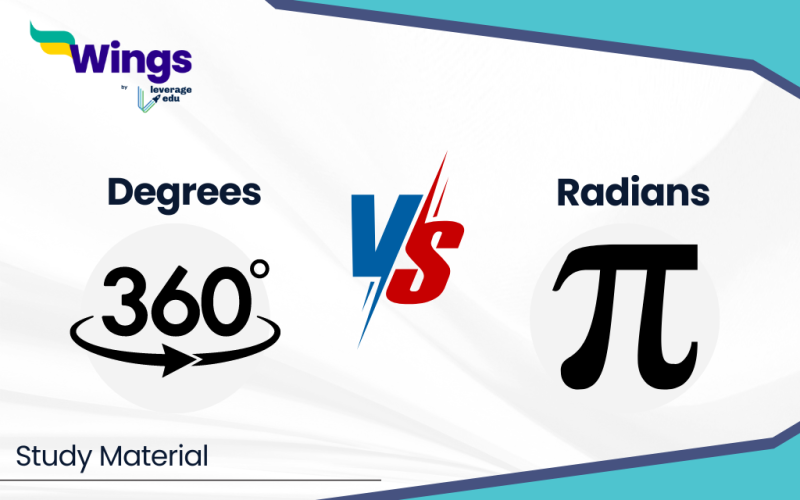Two commonly used units of measurement for angles are degrees and radians. In mathematics and science, many units of measurement are used to implement ratios, etc.
There are many similarities between these two terms and some differences as well. Keep scrolling to know these differences, along with their application in daily life.
Table of Contents [show]
What is Degree?
“Degree” means a unit of measurement to calculate angles. This term is used in Geometry and Trigonometry to know angles and rotation. The full circle is divided into 360 degrees.
For example, a right angle, which is commonly found in geometric shapes like squares and rectangles, measures 90 degrees.
What is Radian?
A radian is defined as the angle subtended at the centre of a circle by an arc whose length is equal to the radius of the circle.
Radians range from 0 to 2π, where 2π radians depict a complete rotation or circle.
Also Read: Difference Between Parallel and Perpendicular
What is the Difference between Degrees and Radians?
Here’s the difference between Degrees and Radian in terms of different angles:
| Measure of an Angle in Degrees | Measure of an Angle in Radians |
| 0° | 0 |
| 30° | 30° × (π/180°) = π/6 = 0.524 Rad |
| 45° | 45° × (π/180°) = π/4 = 0.785 Rad |
| 60° | 60° × (π/180°) = π/3 = 1.047 Rad |
| 90° | 90° × (π/180°) = π/2 = 1.571 Rad |
| 120° | 120° × (π/180°) = 2π/3 = 2.094 Rad |
| 150° | 150° × (π/180°) = 5π/6 = 2.618 Rad |
| 180° | 180° × (π/180°) = π = 3.14 Rad |
| 210° | 210° × (π/180°) = 7π/6 = 3.665 Rad |
| 240° | 240° × (π/180°) = 4π/3 = 4.188 Rad |
| 270° | 270° × (π/180°) = 3π/2 = 4.713 Rad |
| 300° | 300° × (π/180°) = 5π/3 = 5.235 Rad |
| 330° | 330° × (π/180°) = 11π/6 = 5.764 Rad |
| 360° | 360° × (π/180°) = 2π = 6.283 Rad |
Degrees and Radians Formulas
Here’s the tabular representation of different formulas for Degrees and Radians:
Degrees and Radians Chart
| Degrees | Radians |
| Radians × (180/π) | Degrees × (π/180) |
Application of Degrees and Radians in Real Life
Here are some of the applications for Degrees and Radians in different aspects of life:
- Degrees are commonly used in navigation systems, such as GPS devices and compasses, to specify directions and bearings.
- Engineers and architects use degrees and radians to design structures, determine angles for slopes, and calculate the rotation of mechanical parts.
- Astronomers use radians to measure the distances between stars and galaxies.
- Radians are particularly relevant in sports involving circular motion, such as cycling and skateboarding.
Also Read: Chain Rule Questions and Answers
FAQ’s
A lot of people prefer using the Radians unit instead of Degrees in Mathematics, and Science.
To convert radians to degrees, multiply the number of radians by 180/π.
The value of 10 degrees 30 in radians is 51π / 900.
RELATED BLOGS
This was all about the “Difference Between Degrees and Radians”. For more such informative blogs, check out our Study Material Section, you can learn more about us by visiting our Indian exams page.
 One app for all your study abroad needs
One app for all your study abroad needs















 45,000+ students trusted us with their dreams. Take the first step today!
45,000+ students trusted us with their dreams. Take the first step today!
